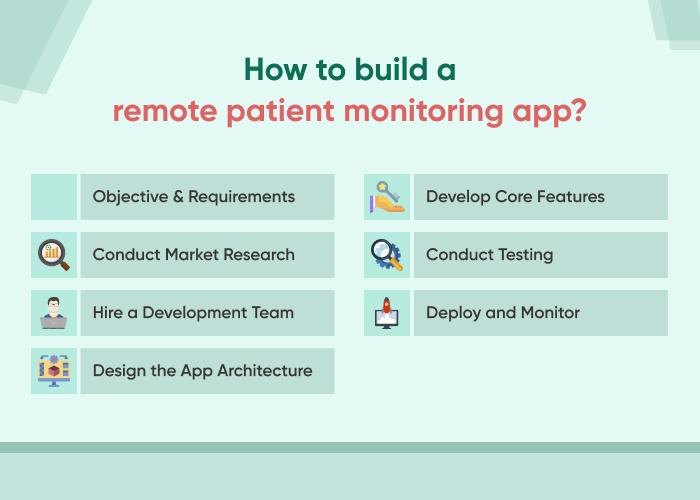What are the must-have features to add to RPM software?

Creating efficient remote patient monitoring software entails combining a number of critical aspects to provide complete and usable functioning. Here are the must-have features to consider:
Real-Time Data Collection and Monitoring
- Sensor Integration: Collect health details by connecting to a variety of medical equipment and sensors.
- Continuous Monitoring: Allow real-time data gathering and presentation for continual health tracking.
Alerts and Notifications
- Threshold notifications: Patients and healthcare providers must get automatic notifications when readings surpass predetermined thresholds.
- Medication Reminders: These notifications are to remind patients to take their prescriptions as recommended.
User-Friendly Interface
- Patient Dashboard: This is a simple interface for patients to view and analyze their health data and trends.
- Clinician Dashboard: Include a detailed and comprehensive interface for healthcare providers to monitor multiple patients’ data.
Data Visualization
- Graphs and Charts: Visual depictions of health data across time can aid consumers and clinicians in understanding patterns and changes.
- Customizable Views: Users can customize how data is displayed according to their preferences.
Communication Tools
- Secure Messaging: An encrypted messaging platform enabling patients and healthcare practitioners should be added to interact.
- Telehealth Integration: Furthermore, add video conferencing capabilities for virtual consultations and check-ups.
Customizable Health Plans
- Personalized Care Plans: Create and manage individualized care plans tailored to patients’ needs and conditions.
- Progress Tracking: Tools for tracking adherence and progress against the personalized care plan.
Multi-Device Compatibility
- Cross-Platform Functionality: Ensure the software is accessible on various devices like smartphones, tablets, desktops, and operating systems like iOS, Android, and Windows.
How to build a remote patient monitoring app?
To build the best remote patient monitoring software, below are the steps to be followed.
- Objective & Requirements: Start by outlining your app’s objectives precisely. Decide which particular health metrics you want to track and who your target audience is. Comprehending these requirements will aid in molding the attributes and operations of your application.
- Conduct Market Research: Examine current patient monitoring solutions to determine their advantages and disadvantages. This is because you may create an efficient and user-friendly app with the aid of our study.
- Hire a Development Team: Create a team or get outsourcing services. You must have a UI/UX team, an app development team, health tech experts, a project manager, and a QA team.
- Design the App Architecture: Plan the technical architecture of your app, considering UI/UX, data collection, data storage, etc. You must involve integration with medical devices and sensors for real-time data acquisition.
- Develop Core Features: Build the essential features of your remote patient monitoring software that includes real-time monitoring, communication tools, data visualization, and integration capabilities.
- Conduct Testing: Test your app thoroughly to verify it is stable, user-friendly, and bug-free. Include functional testing to ensure that all features perform as intended. Furthermore, usability testing is performed to verify that the app is user-friendly for both patients and providers. Moreover, perform performance testing to evaluate the app’s performance under various situations and loads.
- Deploy and Monitor: Launch your app on relevant app stores and market it through the right channels. After launch, regularly monitor its performance, collect customer input, and make any required changes and enhancements.
Conclusion
Building remote patient monitoring software is a challenging task and needs careful planning, a thorough grasp of healthcare requirements, and a solid technology base.
Follow the processes mentioned above like identifying objectives and doing market research. Furthermore, build a qualified development team and monitor the development process to produce the best remote patient monitoring software.
Include must-have features like real-time monitoring, encrypted communication, and data visualization to guarantee your app serves the demands of both patients and healthcare practitioners. As the healthcare landscape evolves, investing in a high-quality remote patient monitoring app will put you at the cutting edge of creative care delivery.
FAQs
How much does it cost to develop a remote patient monitoring app?
What are the regulatory considerations for remote patient monitoring software?
How long does it take to develop an RPM app?
Can RPM apps integrate with existing Electronic Health Records systems?
What kind of support is needed post-deployment?
Ravi Bhojani is the Chief Marketing Officer (CMO) at Alian Software, where he spearheads the company’s marketing strategies and drives its brand presence in the competitive IT services landscape. With over a decade of experience in the technology and marketing sectors, Ravi has consistently demonstrated his ability to blend innovative marketing techniques with deep industry knowledge to deliver outstanding results.